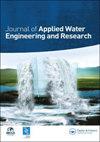使用不同类型的活性炭从水溶液中吸附亚甲基蓝
IF 1.6
Q4 WATER RESOURCES
Journal of Applied Water Engineering and Research
Pub Date : 2022-09-16
DOI:10.1080/23249676.2022.2120918
引用次数: 4
摘要
在这项研究中,研究了四种类型的吸附剂在固定床系统中吸附去除水溶液中亚甲基蓝MB的能力。所使用的吸附剂有活性炭(AC)、人造活性炭(ACPP1)、硝酸(10% wt)化学活性炭(ACPP2)和硝酸与H2SO4(1:1比例)活性炭(ACPP3)。通过28个实验考察了MB浓度、吸附剂床层深度和溶液流速对吸附效果的影响。采用非线性回归分析了Langmuir和Freundlich等温模型。对于AC和ACPP1,吸附发生在多相和多层表面。而对于ACPP2和ACPP3吸附剂,MB在ACPP2和ACPP3上的最大吸附量分别为33.149 mg/g和38.508 mg/g。研究了流量(132,200和250 cc/min)、床层高度(0.05、0.1和0.15 m)和初始MB浓度(150、300和500 mg/l)对突破曲线性能的影响。Bohart-Adams和Thomas-BDST模型对固定床数据的分析具有较好的相关性。本文章由计算机程序翻译,如有差异,请以英文原文为准。
Adsorption of methylene blue from aqueous solution using different types of activated carbon
In this study, four types of adsorbents were examined for their ability to remove methylene blue MB from aqueous solution by adsorption in a fixed bed system. The adsorbents used were activated carbon (AC), manufactured activated carbon (ACPP1), chemically activated carbon with nitric acid (10% wt) (ACPP2), and with nitric acid and H2SO4 (ratio 1:1) (ACPP3). 28 experiments were conducted to test the effect of MB concentrations, adsorbent bed depth, and solution flow rate. Langmuir and Freundlich as isotherm models were analyzed by nonlinear regression. For AC and ACPP1 the adsorption occurred under heterogeneous and multilayer surfaces. Conversely, for ACPP2 and ACPP3 adsorbent, homogeneous and monolayer control adsorption of MB on this adsorbent and maximum adsorption capacity was 33.149 and 38.508 mg/g for MB onto ACPP2 and ACPP3, respectively. The effect of the flow rate (132,200 and 250 cc/min), bed height (0.05, 0.1, and 0.15 m), and initial MB concentration (150, 300, and 500 mg/l) on the performance of the breakthrough curves were clarified. The Bohart-Adams and Thomas-BDST models have a better correlation in relation to the analysis of fixed bed data.
求助全文
通过发布文献求助,成功后即可免费获取论文全文。
去求助
来源期刊

Journal of Applied Water Engineering and Research
WATER RESOURCES-
CiteScore
2.90
自引率
16.70%
发文量
31
期刊介绍:
JAWER’s paradigm-changing (online only) articles provide directly applicable solutions to water engineering problems within the whole hydrosphere (rivers, lakes groundwater, estuaries, coastal and marine waters) covering areas such as: integrated water resources management and catchment hydraulics hydraulic machinery and structures hydraulics applied to water supply, treatment and drainage systems (including outfalls) water quality, security and governance in an engineering context environmental monitoring maritime hydraulics ecohydraulics flood risk modelling and management water related hazards desalination and re-use.
 求助内容:
求助内容: 应助结果提醒方式:
应助结果提醒方式:


